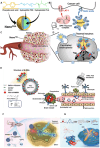Boron Nanocomposites for Boron Neutron Capture Therapy and in Biomedicine: Evolvement and Challenges
- PMID: 40008112
- PMCID: PMC11850861
- DOI: 10.34133/bmr.0145
Boron Nanocomposites for Boron Neutron Capture Therapy and in Biomedicine: Evolvement and Challenges
Abstract
Cancer remains a major concern for human health worldwide. To fight the curse of cancer, boron neutron capture therapy is an incredibly advantageous modality in the treatment of cancer as compared to other radiotherapies. Due to tortuous vasculature in and around tumor regions, boron (10B) compounds preferentially house into tumor cells, creating a large dose gradient between the highly mingled cancer cells and normal cells. Epithermal or thermal neutron bombardment leads to tumor-cell-selective killing due to the generation of heavy particles yielded from in situ fission reaction. However, the major challenges for boron nanocomposites' development have been from the synthesis part as well as the requirement for selective cancer targeting and the delivery of therapeutic concentrations of boron (10B) with nominal healthy tissue accumulation and retention. To circumvent the above challenges, this review discusses boride nanocomposite design, safety, and biocompatibility for biomedical applications for general public use. This review sparks interest in using boron nanocomposites as boron neutron capture therapy agents and repurposing them in comorbidity treatments, with future scientific challenges and opportunities, with a hope to accelerate the stimulus of developing possible boron composite nanomedicine research and applications worldwide.
Copyright © 2025 Farooq Ahmad.
Conflict of interest statement
Competing interests: The author declares that he has no competing interests.
Figures






Similar articles
-
Boron neutron capture therapy of cancer: current status and future prospects.Clin Cancer Res. 2005 Jun 1;11(11):3987-4002. doi: 10.1158/1078-0432.CCR-05-0035. Clin Cancer Res. 2005. PMID: 15930333 Review.
-
Current status of boron neutron capture therapy of high grade gliomas and recurrent head and neck cancer.Radiat Oncol. 2012 Aug 29;7:146. doi: 10.1186/1748-717X-7-146. Radiat Oncol. 2012. PMID: 22929110 Free PMC article. Review.
-
Boron Neutron Capture Therapy: Clinical Application and Research Progress.Curr Oncol. 2022 Oct 18;29(10):7868-7886. doi: 10.3390/curroncol29100622. Curr Oncol. 2022. PMID: 36290899 Free PMC article. Review.
-
Advancements in Tumor Targeting Strategies for Boron Neutron Capture Therapy.Pharm Res. 2015 Sep;32(9):2824-36. doi: 10.1007/s11095-015-1718-y. Epub 2015 Jun 2. Pharm Res. 2015. PMID: 26033767 Review.
-
Boron neutron capture therapy of brain tumors: an emerging therapeutic modality.Neurosurgery. 1999 Mar;44(3):433-50; discussion 450-1. doi: 10.1097/00006123-199903000-00001. Neurosurgery. 1999. PMID: 10069580 Review.
References
-
- Sweet WH. The uses of nuclear disintegration in the diagnosis and treatment of brain tumor. N Engl J Med. 1951;245(23):875–878. - PubMed
-
- Choi G, Jeon I-R, Piao H, Choy J-H. Highly condensed boron cage cluster anions in 2D carrier and its enhanced antitumor efficiency for boron neutron capture therapy. Adv Funct Mater. 2018;28(27): Article 1704470.
-
- Coderre JA, Morris GM. The radiation biology of boron neutron capture therapy. Radiat Res. 1999;151(1):1–18. - PubMed
-
- Achilli C, Grandi S, Ciana A, Guidetti GF, Malara A, Abbonante V, Cansolino L, Tomasi C, Balduini A, Fagnoni M, et al. . Biocompatibility of functionalized boron phosphate (BPO4) nanoparticles for boron neutron capture therapy (BNCT) application. Nanomedicine. 2014;10(3):589–597. - PubMed
-
- Michiue H, Kitamatsu M, Fukunaga A, Tsuboi N, Fujimura A, Matsushita H, Igawa K, Kasai T, Kondo N, Matsui H, et al. . Self-assembling A6K peptide nanotubes as a mercaptoundecahydrododecaborate (BSH) delivery system for boron neutron capture therapy (BNCT). J Control Release. 2020;330:788–796. - PubMed
Publication types
LinkOut - more resources
Full Text Sources

